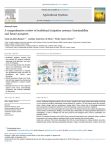da-Silva-Branco C., de Brito António G., Seixas P.C. (2026). A comprehensive review of traditional irrigation systems: sustainability and future prospects. Agricultural systems, 01/01/2026, vol. 231, p. 104481.
https://doi.org/10.1016/j.agsy.2025.104481
https://doi.org/10.1016/j.agsy.2025.104481
| Titre : | A comprehensive review of traditional irrigation systems: sustainability and future prospects (2026) |
| Auteurs : | C. da-Silva-Branco ; António G. de Brito ; P.C. Seixas |
| Type de document : | Article |
| Dans : | Agricultural systems (vol. 231, January 2026) |
| Article en page(s) : | p. 104481 |
| Langues : | Anglais |
| Langues du résumé : | Anglais |
| Catégories : |
Catégories principales 07 - ENVIRONNEMENT ; 7.3 - Eau. Gestion de l'EauThésaurus IAMM IRRIGATION ; METHODE D'IRRIGATION ; METHODE TRADITIONNELLE ; DURABILITE |
| Résumé : | Context Traditional Irrigation Systems (TIS) are ancient, complex hydro-social systems that entangle a network of socio-technical-ecological relationships, having endured for centuries. TIS faces threats from rural desertification, climate change, and poor maintenance, among others. These systems rely on knowledge transmitted across generations and practices tailored to local environmental, social, and economic conditions. Objective The aim is to review and analyse the current state of TIS-related research, the evolution of publications, research themes, methodologies, findings, and research gaps. Additionally, by examining different dimensions of sustainability, it seeks to identify how TIS have preserved and managed water resources sustainably over extended periods. Methods A systematic literature review (SLR) of peer-reviewed journal articles was conducted, using a combined scientometric and content analysis techniques based on data extracted from selected studies. Results and conclusions This review demonstrates that TIS are not just historical or cultural artefacts, but active, multifunctional systems reflecting sustainability principles. Using a four-pillar framework, evidence shows that TIS play a crucial role in environmental stewardship through biodiversity conservation, water and energy efficiency, and landscape protection; their economic sustainability relies on low-cost practices, resource sharing, and ecosystem services that benefit rural communities; inclusion, traditional rights, and cultural identities are supported; governance contributes to their success by aiding community coordination, conflict resolution, and planning. Findings emphasise that 1) sustainability strategies should be tailored to local contexts to be effective, equitable, and ensure long-term preservation; 2) it is important to integrate traditional knowledge with modern practices to enhance TIS's sustainability, especially in the face of climate change; 3) TIS should be incorporated into broader conservation, rural development, and climate change strategies, policies, and plans, with inclusive solutions aligned with local capacities; 4) policy implications include the need for integrated policy coordination and participatory community planning, as well as recognising TIS as cultural heritage; 5) cost-effective strategies should prioritise local governance, affordable infrastructure maintenance, and technical support. Significance This review provides a comprehensive roadmap for revitalising TIS as a crucial asset for sustainable water governance and rural resilience, based on evidence across the four pillars of sustainability: environmental stewardship, economic viability, social equity, and governance. |
| Cote : | En ligne |
| URL / DOI : | https://doi.org/10.1016/j.agsy.2025.104481 |







